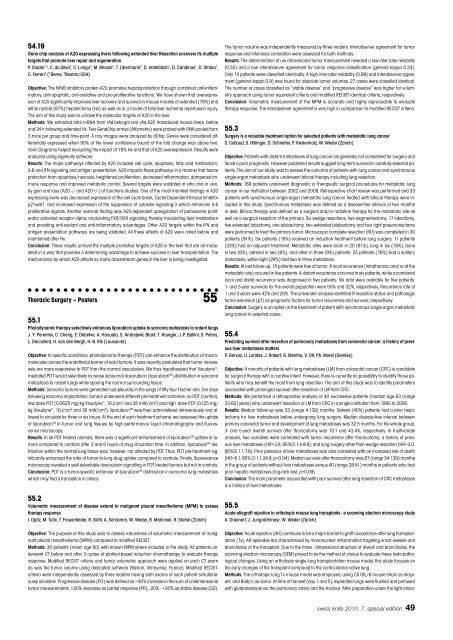Anorectal Manometry in 3D NEW! - Swiss-knife.org
Anorectal Manometry in 3D NEW! - Swiss-knife.org
Anorectal Manometry in 3D NEW! - Swiss-knife.org
You also want an ePaper? Increase the reach of your titles
YUMPU automatically turns print PDFs into web optimized ePapers that Google loves.
54.19<br />
Gene chip analysis of A20 express<strong>in</strong>g livers follow<strong>in</strong>g extended liver Resection uncovers its multiple<br />
targets that promote liver repair and regeneration<br />
P. Studer 1,2 , C. da Silva 2 , C. Longo 2 , M. Bhas<strong>in</strong> 2 , T. Libermann 2 , D. Inderbitz<strong>in</strong> 1 , D. Cand<strong>in</strong>as 1 , D. Stroka 1 ,<br />
C. Ferran 2 ( 1 Berne, 2 Boston/USA)<br />
Objective: The NFkB <strong>in</strong>hibitory prote<strong>in</strong> A20 promotes hepatoprotection through comb<strong>in</strong>ed anti-<strong>in</strong>flammatory,<br />
anti-apoptotic, anti-oxidative and pro-proliferative functions. We have shown that overexpression<br />
of A20 significantly improves liver recovery and survival <strong>in</strong> mouse models of extended (78%) and<br />
lethal radical (87%) hepatectomy (Hx) as well as <strong>in</strong> a model of total liver ischemia reperfusion <strong>in</strong>jury.<br />
The aim of this study was to unravel the molecular targets of A20 <strong>in</strong> the liver.<br />
Methods: We extracted total mRNA from rAd.beta-gal and rAd.A20 transduced mouse livers, before<br />
and 24 h follow<strong>in</strong>g extended Hx. Two GeneChip arrays (Affymetrix) were probed with RNA pooled from<br />
3 mice per group and time-po<strong>in</strong>t. A rray images were analyzed by dChip. Genes were considered differentially<br />
expressed when 90% of the lower confidence bound of the fold change was above two.<br />
Venn Diagrams helped evaluat<strong>in</strong>g the impact of 78% Hx and that of A20 overexpression. Results were<br />
analyzed us<strong>in</strong>g Ingenuity software.<br />
Results: The major pathways affected by A20 <strong>in</strong>cluded cell cycle, apoptosis, fatty acid metabolism,<br />
IL-6 and IFN signal<strong>in</strong>g and antigen presentation. A20 impacts these pathways <strong>in</strong> a manner that favors<br />
protection from apoptosis/necrosis, heightened proliferation, decreased <strong>in</strong>flammation, dampened immune<br />
response and improved metabolic control. Several targets were validated <strong>in</strong> vitro and <strong>in</strong> vivo,<br />
by ga<strong>in</strong> and loss (A20 -/- and A20+/-) of functions studies. One of the most manifest f<strong>in</strong>d<strong>in</strong>gs <strong>in</strong> A20<br />
express<strong>in</strong>g livers was decreased expression of the cell cycle break, Cycl<strong>in</strong> Dependent K<strong>in</strong>ase Inhibitor<br />
p21waf1, and <strong>in</strong>creased expression of the suppressor of cytok<strong>in</strong>e signal<strong>in</strong>g-3 which enhances IL-6<br />
proliferative signals. Another sem<strong>in</strong>al f<strong>in</strong>d<strong>in</strong>g was A20-dependent upregulation of peroxisome proliferator<br />
activated receptor alpha, modulat<strong>in</strong>g FXR/RXR signal<strong>in</strong>g, thereby modulat<strong>in</strong>g lipid metabolism<br />
and provid<strong>in</strong>g anti-oxidant and anti-<strong>in</strong>flammatory advantages. Other A20 targets with<strong>in</strong> the IFN and<br />
antigen presentation pathways are be<strong>in</strong>g validated. All these effects of A20 were noted before and<br />
ma<strong>in</strong>ta<strong>in</strong>ed after Hx.<br />
Conclusion: These results unravel the multiple protective targets of A20 <strong>in</strong> the liver that are all modulated<br />
<strong>in</strong> a way that provides a determ<strong>in</strong><strong>in</strong>g advantage to achieve success <strong>in</strong> liver transplantation. The<br />
mechanisms by which A20 affects so many downstream genes <strong>in</strong> the liver is be<strong>in</strong>g <strong>in</strong>vestigated.<br />
Thoracic Surgery – Posters 55<br />
55.1<br />
Photodynamic therapy selectively enhances liporubic<strong>in</strong> uptake <strong>in</strong> sarcoma metastasis to rodent lungs<br />
J. Y. Perentes, C. Cheng, E. Debefve, A. Haouala, S. Andrejevic Blant, T. Krueger, J.-P. Ball<strong>in</strong>i, S. Peters,<br />
L. Decosterd, H. van den Bergh, H.-B. Ris (Lausanne)<br />
Objective: In specific conditions, photodynamic therapy (PDT) can enhance the distribution of macromolecules<br />
across the endothelial barrier of solid tumors. It was recently postulated that tumor neovessels<br />
are more responsive to PDT than the normal vasculature. We thus hypothesized that Visudyne ® -<br />
mediated PDT would selectively <strong>in</strong>crease liposomal doxorubic<strong>in</strong> (liporubic<strong>in</strong> TM ) distribution <strong>in</strong> sarcoma<br />
metastasis to rodent lungs while spar<strong>in</strong>g the normal surround<strong>in</strong>g tissue.<br />
Methods: Sarcoma tumors were generated sub-pleurally <strong>in</strong> the lungs of fifty-four Fischer rats. Ten days<br />
follow<strong>in</strong>g sarcoma implantation, tumors underwent different pre-treatment schemes: no PDT (control),<br />
low dose PDT (0.0625 mg/kg Visudyne ® , 10J/cm 2 and 35 mW/cm 2 ) and high- dose PDT (0.125 mg/<br />
kg Visudyne ® , 10J/cm 2 and 35 mW/cm 2 ). liporubic<strong>in</strong> TM was then adm<strong>in</strong>istered <strong>in</strong>travenously and allowed<br />
to circulate for three or six hours. At the end of each treatment scheme, we assessed the uptake<br />
of liporubic<strong>in</strong> TM <strong>in</strong> tumor and lung tissues by high performance liquid chromatography and fluorescence<br />
microscopy.<br />
Results: In all PDT-treated animals, there was a significant enhancement of liporubic<strong>in</strong> TM uptake <strong>in</strong> tumors<br />
compared to controls after 3 and 6 hours of drug circulation time. In addition, liporubic<strong>in</strong> TM distribution<br />
with<strong>in</strong> the normal lung tissue was, however, not affected by PDT. Thus, PDT pre-treatment significantly<br />
enhanced the ratio of tumor-to-lung drug uptake compared to controls. F<strong>in</strong>ally, fluorescence<br />
microscopy revealed a well detectable doxorubic<strong>in</strong> signall<strong>in</strong>g <strong>in</strong> PDT treated tumors but not <strong>in</strong> controls.<br />
Conclusion: PDT is a tumor-specific enhancer of liporubic<strong>in</strong> TM distribution <strong>in</strong> sarcoma lung metastasis<br />
which may f<strong>in</strong>d a translation <strong>in</strong> cl<strong>in</strong>ics.<br />
55.2<br />
Volumetric measurement of disease extend <strong>in</strong> malignant pleural mesothelioma (MPM) to assess<br />
therapy response<br />
I. Opitz, M. Tutic, T. Frauenfelder, R. Götti, A. Schramm, W. Weder, B. Mar<strong>in</strong>cek, R. Stahel (Zürich)<br />
Objective: The purpose of this study was to assess robustness of volumetric measurement of malignant<br />
pleural mesothelioma (MPM) compared to modified RECIST.<br />
Methods: 30 patients (mean age 60) with known MPM where <strong>in</strong>cluded <strong>in</strong> the study. All patients underwent<br />
CT before and after 3 cycles of plat<strong>in</strong>ol-based <strong>in</strong>duction chemotherapy to evaluate therapy<br />
response. Modified RECIST criteria and tumor volumetric approach were applied on each CT exam<br />
as was the tumor volume us<strong>in</strong>g dedicated software (Myrian, Intrasense, France). Modified RECISTcriteria<br />
were <strong>in</strong>dependently assessed by three readers hav<strong>in</strong>g both exams of each patient simultaneously<br />
available. Progressive disease (PD) was def<strong>in</strong>ed as >30% <strong>in</strong>crease <strong>in</strong> the sum of unidimensional<br />
tumor measurements, >20% decrease as partial response (PR), -20% - +30% as stable disease (SD).<br />
The tumor volume was <strong>in</strong>dependently measured by three readers. Interobserver agreement for tumor<br />
response and <strong>in</strong>terclass correlation were assessed for both methods.<br />
Results: The determ<strong>in</strong>ation of uni-dimensional tumor measurement revealed a low <strong>in</strong>ter-rater reliability<br />
(0.55) and a low <strong>in</strong>terobserver agreement for tumor response classification (general kappa 0.33).<br />
Only 14 patients were classified identically. A high <strong>in</strong>ter-rater reliability (0.99) and <strong>in</strong>terobserver agreement<br />
(general kappa 0.9) was found for absolute tumor volumes. 27 cases were classified identical.<br />
The number of cases classified as “stable disease” and “progressive disease” was higher for volumetry<br />
approach us<strong>in</strong>g tumor equivalent criteria and modified RECIST identical criteria, respectively.<br />
Conclusion: Volumetric measurement of the MPM is accurate and highly reproducible to evaluate<br />
therapy response. The <strong>in</strong>terobserver agreement is very high <strong>in</strong> comparison to modified RECIST criteria.<br />
55.3<br />
Surgery is a valuable treatment option for selected patients with metastatic lung cancer<br />
S. Collaud, S. Hill<strong>in</strong>ger, D. Schneiter, P. Kestenholz, W. Weder (Zürich)<br />
Objective: Patients with distant metastases of lung cancer are generally not considered for surgery and<br />
faced a poor prognostic. However published results suggest long-term survival <strong>in</strong> carefully selected patients.<br />
The aim of our study was to assess the outcome of patients with lung cancer and synchronous<br />
s<strong>in</strong>gle-<strong>org</strong>an metastasis who underwent bifocal therapy <strong>in</strong>clud<strong>in</strong>g lung resection.<br />
Methods: 169 patients underwent diagnostic or therapeutic surgical procedures for metastatic lung<br />
cancer <strong>in</strong> our <strong>in</strong>stitution between 2002 and 2008. Retrospective chart review was performed and 33<br />
patients with synchronous s<strong>in</strong>gle-<strong>org</strong>an metastatic lung cancer treated with bifocal therapy were <strong>in</strong>cluded<br />
<strong>in</strong> this study. Synchronous metastasis was def<strong>in</strong>ed as a disease-free <strong>in</strong>terval of two months<br />
or less. Bifocal therapy was def<strong>in</strong>ed as a surgical and/or radiation therapy for the metastatic site as<br />
well as a surgical resection of the primary. Six wedge resections, two segmentectomy, 17 lobectomy,<br />
five extended lobectomy, one bilobectomy, two extended bilobectomy and two right pneumonectomy<br />
were performed to treat the primary tumor. Microscopic complete resection (R0) was completed <strong>in</strong> 30<br />
patients (91%). Six patients (18%) received an <strong>in</strong>duction treatment before lung surgery. 11 patients<br />
(33%) had an adjuvant treatment. Metastatic sites were bra<strong>in</strong> <strong>in</strong> 20 (61%), lung <strong>in</strong> six (18%), bone<br />
<strong>in</strong> two (6%), adrenal <strong>in</strong> two (6%), and other <strong>in</strong> three (9%) patients. 25 patients (76%) had a solitary<br />
metastasis, while eight (24%) had two to three metastasis.<br />
Results: At last follow-up, 15 patients were free of tumor. A local recurrence (<strong>in</strong>trathoracic and/or at the<br />
metastatic site) occured <strong>in</strong> five patients. A distant recurrence occurred <strong>in</strong> six patients, while a comb<strong>in</strong>ed<br />
local and distal recurrence was diagnosed <strong>in</strong> two patients. No data were available for five patients.<br />
1- and 3-year survivals for the overall population were 50% and 32%, respectively. Recurrence rate at<br />
1 and 3 years were 42% and 28%. The univariate analysis identified R resection status and pathologic<br />
tumor extension (pT) as prognostic factors for tumor recurrence and survival, respectively.<br />
Conclusion: Surgery is an option <strong>in</strong> the treatment of patient with synchronous s<strong>in</strong>gle-<strong>org</strong>an metastatic<br />
lung cancer <strong>in</strong> selected cases.<br />
55.4<br />
Predict<strong>in</strong>g survival after resection of pulmonary metastases from colorectal cancer: a history of previous<br />
liver metastases matters<br />
P. Gervaz, U. Landes, J. Robert, G. Mentha, V. Ott, Ph. Morel (Genève)<br />
Objective: A m<strong>in</strong>ority of patients with lung metastases (LM) from colorectal cancer (CRC) is candidate<br />
for surgical therapy with a curative <strong>in</strong>tent. However, there is currently no possibility to identify those patients<br />
who may benefit the most from lung resection. The aim of this study was to identify parameters<br />
associated with prolonged survival after resection of LM from CRC.<br />
Methods: We performed a retrospective analysis of 40 successive patients (median age 63 [range<br />
33-82] years) who underwent resection of LM from CRC <strong>in</strong> a s<strong>in</strong>gle <strong>in</strong>stitution from 1990 to 2008.<br />
Results: Median follow-up was 33 (range 4-139) months. Sixteen (40%) patients had a prior hepatectomy<br />
for liver metastases before undergo<strong>in</strong>g lung surgery. Median disease-free <strong>in</strong>terval between<br />
primary colorectal tumor and development of lung metastases was 32.5 months. For the whole group,<br />
3- and 5-year overall survival after thoracotomy was 70.1 and 43.4%, respectively. In multivariate<br />
analysis, two variables were correlated with tumor recurrence after thoracotomy; a history of previous<br />
liver metastases (HR=3.8, 95%CI 1.4-9.8); and lung surgery other than wedge resection (HR=3.0,<br />
95%CI 1.1-7.8). Prior presence of liver metastases was also correlated with an <strong>in</strong>creased risk of death<br />
(HR=5.1, 95% CI 1.1-24.8, p=0.04). Median survival after thoracotomy was 87 (range 34-139) months<br />
<strong>in</strong> the group of patients without liver metastases versus 40 (range 28-51) months <strong>in</strong> patients who had<br />
prior hepatic metastases (log-rank test, p=0.09).<br />
Conclusion: The ma<strong>in</strong> parameter associated with poor survival after lung resection of CRC metastases<br />
is a history of liver metastases.<br />
55.5<br />
Acute allograft rejection <strong>in</strong> orthotopic mouse lung transplants - a scann<strong>in</strong>g electron microscopy study<br />
A. Draenert, J. Jungraithmayr, W. Weder (Zürich)<br />
Objective: Acute rejection (AR) cont<strong>in</strong>ues to be a major barrier to graft acceptance after lung transplantation<br />
(Tx). AR episodes are characterized by mononuclear <strong>in</strong>flammation target<strong>in</strong>g small vessels and<br />
bronchioles of the transplant. Due to the three - dimensional structure of alveoli and bronchioles, the<br />
scann<strong>in</strong>g electron microscopy (SEM) proved to be the method of choice to evaluate these histo-pathological<br />
changes. Us<strong>in</strong>g an orthotopic s<strong>in</strong>gle lung transplantation mouse model, this study focuses on<br />
the early changes of the transplant compared to the contra-lateral native lung.<br />
Methods: The orthotopic lung Tx mouse model was employed, us<strong>in</strong>g C57BL/6 mouse stra<strong>in</strong> as recipient,<br />
and Balb/c as donor. At time of harvest (day 1 and 5), explanted lungs were flushed and perfused<br />
with glutaraldehyde via the pulmonary artery and the trachea. After preparation under the light micro-<br />
swiss <strong>knife</strong> 2010; 7: special edition 49
















